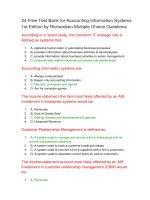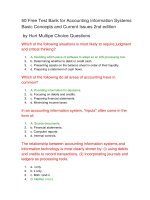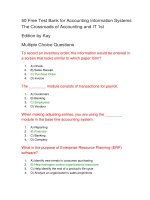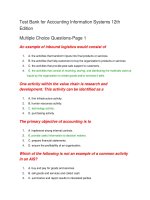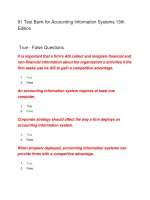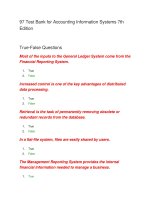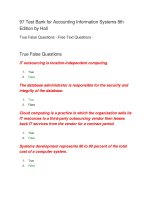97 test bank for accounting information systems 8th edition by hall
Bạn đang xem bản rút gọn của tài liệu. Xem và tải ngay bản đầy đủ của tài liệu tại đây (118.89 KB, 24 trang )
97 Test Bank for Accounting Information Systems 8th
Edition by Hall
True False Questions - Free Text Questions -
True False Questions
IT outsourcing is location-independent computing.
1.
True
2.
False
The database administrator is responsible for the security and integrity of the
database.
1.
True
2.
False
Cloud computing is a practice in which the organization sells its IT resources
to a third-party outsourcing vendor then leases back IT services from the
vendor for a contract period.
1.
True
2.
False
Systems development represents 80 to 90 percent of the total cost of a
computer system.
1.
True
2.
False
The internal auditor represents the interests of third-party outsiders.
1.
True
2.
False
Custom software is the most affordable systems development option.
1.
True
2.
False
A database is a collection of interconnected computers and communications
devices that allows users to communicate, access data and applications, and
share information and resources.
1.
True
2.
False
The Management Reporting System provides the internal financial information
needed to manage a business.
1.
True
2.
False
Retrieval is the task of permanently removing obsolete or redundant records
from the database.
1.
True
2.
False
Custom software is completely finished, tested, and ready for
implementation.
1.
True
2.
False
Most of the inputs to the General Ledger System come from the Financial
Reporting System.
1.
True
2.
False
Transaction processing systems convert non-financial transactions into
financial transactions.
1.
True
2.
False
Information is a business resource.
1.
True
2.
False
Information Technology (IT) audits can be performed by both internal and
external auditors.
1.
True
2.
False
A balance sheet prepared in conformity with GAAP is an example of
discretionary reporting.
1.
True
2.
False
A potential benefit of cloud computing is that the client firm does not need to
know where its data are bring processed.
1.
True
2.
False
Information lacking reliability may still have value.
1.
True
2.
False
One of the greatest disadvantages of database systems is that all data is
always available to all users.
1.
True
2.
False
Under SOX legislation public accounting firms are no longer allowed to
provide consulting services to audit clients.
1.
True
2.
False
Systems maintenance consumes the majority of a system’s total costs.
1.
True
2.
False
When preparing discretionary reports, organizations can choose what
information to report and how to present it.
1.
True
2.
False
Under SOX legislation public accounting firms are no longer allowed to
provide consulting services to their clients.
1.
True
2.
False
Multiple Choice Questions
Which of the following is not a production support activity?
1.
a.Maintenance
2.
b.Marketing
3.
c.Production planning
4.
d.Quality control
Which of the following is not a business resource?
1.
a.raw material
2.
b.labor
3.
c.information
4.
d.all are business resources
Advantages of cloud computing include all of the following except
1.
a.Access to whatever computing power is needed
2.
b.Paying only for what is used
3.
c.Unknown data processing location
4.
d.Flexible, short term contracts
These are focuses on the system itself.
1.
a.Cloud computing
2.
b.Fraud audits
3.
c.Substantive tests
4.
d.Tests of controls
The Transaction Processing System includes all of the following cycles
except
1.
a.the revenue cycle
2.
b.the administrative cycle
3.
c.the expenditure cycle
4.
d.the conversion cycle
When designing the data collection activity, which type of data should be
avoided?
1.
a.data that is relevant
2.
b.data that is efficient
3.
c.data that is redundant
4.
d.data that is accurate
Which individuals may be involved in the Systems Development Life Cycle?
1.
a.accountants
2.
b.systems professionals
3.
c.end users
4.
d.all of the above
Motivations for IT outsourcing include each of the following except
1.
a.IT’s highly technical nature
2.
b.Long term contracts in IT outsourcing
3.
c.Expense of IT
4.
d.Dynamically changing nature of IT
Market research and advertising are part of which business function?
1.
a.materials management
2.
b.finance
3.
c.marketing
4.
d.production
Location-independent computing in which shared data centers deliver hosted
IT services over the Internet.
1.
a.IT outsourcing
2.
b.Network administration
3.
c.Cloud computing
4.
d.Custom software
Data processing does not involve
1.
a.data control
2.
b.computer operations
3.
c.system maintenance
4.
d.data conversion
All of the following are external end users except
1.
a.Cost accountants
2.
b.Creditors
3.
c.Stockholders
4.
d.Tax authorities
Database management tasks do not include
1.
a.summarization
2.
b.storage
3.
c.retrieval
4.
d.deletion
The term “accounting independence” refers to
1.
a.data integrity
2.
b.separation of duties, such as record keeping and custody of physical resources
3.
c.generation of accurate and timely information
4.
d.business segmentation by function
An appraisal function housed within the organization that performs a wide
range of services for management is
1.
a.internal auditing
2.
b.data control group
3.
c.external auditing
4.
d.database administration
Which level of management is responsible for short-term planning and
coordination of activities necessary to accomplish organizational objectives?
1.
a.operations management
2.
b.middle management
3.
c.top management
4.
d.line management
The major difference between the Financial Reporting System (FRS) and the
Management Reporting System (MRS) is the
1.
a.FRS provides information to internal and external users; the MRS provides
information to internal users
2.
b.FRS provides discretionary information; the MRS provides nondiscretionary
information
3.
c.FRS reports are prepared using information provided by the General Ledger System;
the MRS provides information to the General Ledger System
4.
d.FRS reports are prepared in flexible, nonstandardized formats; the MRS reports are
prepared in standardized, formal formats
Which subsystem is not part of the Accounting Information System?
1.
a.Transaction Processing System
2.
b.Expert System
3.
c.General Ledger/Financial Reporting System
4.
d.Management Reporting System
The objectives of an information system include each of the following except
1.
a.support for the stewardship responsibilities of management
2.
b.furthering the financial interests of shareholders
3.
c.support for management decision making
4.
d.support for the firm’s day-to-day operations
In a database, a complete set of attributes for a single occurrence of an entity
class is called
1.
a.a key
2.
b.a file
3.
c.a record
4.
d.a character
Useful information must possess all of the following characteristics except
1.
a.relevance
2.
b.precision
3.
c.accuracy
4.
d.completeness
The author distinguishes between the Accounting Information System and the
management Information System based on
1.
a.whether the transactions are financial or nonfinancial
2.
b.whether discretionary or nondiscretionary reports are prepared
3.
c.the end users of the reports
4.
d.the organizational structure of the business
The value of information for users is determined by all of the following but
1.
a.reliability
2.
b.relevance
3.
c.convenience
4.
d.completeness
Which activity is not part of the finance function?
1.
a.cash receipts
2.
b.portfolio management
3.
c.credit
4.
d.general ledger
Which of the following is not a cloud computing service?
1.
a.Software as a service
2.
b.Infrastructure as a service
3.
c.Network as a service
4.
d.Platform as a service
The purpose of the Transaction Processing System includes all of the
following except
1.
a.converting economic events into financial transactions
2.
b.recording financial transactions in the accounting records
3.
c.distributing essential information to operations personnel to support their daily
operations
4.
d.measuring and reporting the status of financial resources and the changes in those
resources
Accountants play many roles relating to the accounting information system,
including all of the following except
1.
a.system users
2.
b.system designers
3.
c.system auditors
4.
d.system converters
Which level of management is responsible for controlling day-to-day
operations?
1.
a.top management
2.
b.middle management
3.
c.operations management
4.
d.executive management
An example of a nonfinancial transaction is
1.
a.sale of products
2.
b.cash disbursement
3.
c.log of customer calls
4.
d.purchase of inventory
The primary input to the Transaction Processing System is
1.
a.a financial transaction
2.
b.an accounting record
3.
c.an accounting report
4.
d.a nonfinancial transaction
Effective information has all of the following characteristics except
1.
a.relevance
2.
b.completeness
3.
c.summarization
4.
d.structure
What factor conceptually distinguishes external auditing and internal
auditing?
1.
a.Tests of controls
2.
b.Substantive tests
3.
c.Education
4.
d.Constituencies
Which function manages the financial resources of the firm through portfolio
management, banking, credit evaluation, and cash receipts and
disbursements?
1.
a.accounting
2.
b.finance
3.
c.materials management
4.
d.distribution
Attestation services are performed by
1.
a.external auditors
2.
b.internal accountants
3.
c.internal auditors
4.
d.third-party accountants
The most basic element of useful data in the database is
1.
a.the record
2.
b.the key
3.
c.the file
4.
d.the attribute
Which individual is least involved in new systems development?
1.
a.systems analyst
2.
b.external auditor
3.
c.end user
4.
d.data librarian
An example of a financial transaction is
1.
a.the purchase of computer
2.
b.a supplier’s price list
3.
c.a delivery schedule
4.
d.an employee benefit brochure
Which of the following is not part of the accounting function?
1.
a.managing the financial information resource of the firm
2.
b.capturing and recording transactions in the database
3.
c.distributing transaction information to operations personnel
4.
d.managing the physical information system of the firm
In the distributed data processing approach
1.
a.computer services are consolidated and managed as a shared organization resource
2.
b.the computer service function is a cost center
3.
c.the end users are billed using a charge-back system
4.
d.computer services are organized into small information processing units under the
control of end users
The objectives of all information systems include all of the following except
1.
a.support for the stewardship function of management
2.
b.evaluating transaction data
3.
c.support for the day-to-day operations of the firm
4.
d.support for management decision making
Free Text Questions
Why do auditors need to understand the organizational structure of the
business?
Answer Given
The structure of an organization reflects the distribution of responsibility, authority, and
accountability throughout the organization. Auditors need to know how the
organization functions to properly audit it.
Two distinct ways to structure the Data Processing Department are
____________________ and ____________________.
Answer Given
centralized, distributed
Sarbanes-Oxley legislation requires that management designs and
implements controls over the entire financial reporting process. What
systems does this include?
Answer Given
This includes the financial reporting system, the general ledger system, and the
transaction processing systems that supply the data for financial reporting.
The task of locating and transferring an existing record from the database for
processing is called data ____________________.
Answer Given
retrieval
How does SOX affect the provision of attest and advisory services?
Answer Given
Prior to the passage of SOX, accounting firms could provide advisory services
concurrently to audit (attest function) clients. SOX legislation, however, greatly restricts
the types of non-audit services that auditors may render audit clients. It is now
unlawful for a registered public accounting firm that is currently providing attest
services for a client to provide the following services: bookkeeping or other services
related to the accounting records or financial statements of the audit client, financial
information systems design and implementation, appraisal or valuation services,
fairness opinions, or contribution-in-kind reports, actuarial services, internal audit
outsourcing services, management functions or human resources, broker or dealer,
investment adviser, or investment banking services, legal services and expert services
unrelated to the audit, or any other service that the Board determines, by regulation, is
impermissible.
The __________________________ and __________________________
standards that characterize the AIS clearly distinguish it from the MIS.
Answer Given
legal, professional
Location-independent sharing of data centers hosting IT servers over Yhe
internet is called ______________________________.
Answer Given
Cloud computing
Compare and contrast IT outsourcing and cloud computing.
Answer Given
IT outsourcing involved an organization selling its IT resources (hardware, software,
and facilities) to a third-party outsourcing vendor and then leasing back IT services
from the vendor for a contract period of typically between five and ten years. A variant
of IT outsourcing, called cloud computing, is location-independent computing whereby
shared data centers deliver hosted IT services over the Internet. An organization
pursuing cloud computing signs a contract with an IT service provider to provide
computing resources. When demand exceeds the provider’s IT capacity, it acquires
additional capacity from data centers in the “cloud” that are connected via the Internet.
The advantage to the client organization is access to whatever computing power it
needs, while it pays only for what it uses. Also, cloud computing contracts are flexible
and relatively short term. In contrast, traditional outsourcing contracts tend to be fixed
price, inflexible, and much longer term.
A practice in which an organization sells its IT resources and leases them
back is called ___________________________________.
Answer Given
IT outsourcing
Two methods to acquire information systems are to
__________________________ and to __________________________.
Answer Given
develop customized systems, purchase commercial systems
Why is it important to organizationally separate the accounting function from
other functions of the organization?
Answer Given
The accounting function provides record-keeping services for all of the operations and
day-to-day activities of other departments, which affect the financial position of the
organization. Record keeping tasks must be kept separate from any area that has
custody over assets. Thus, the accounting function must remain independent so that
the protection of the firm’s assets is carried out in an environment with minimum
possibilities for theft.
Name and explain the purpose of the three major subsystems of the AIS:
Answer Given
TPS records the financial transactions of the firm; GL/FRS produces the financial
statements etc. required by law; MRS provides information to internal management for
decision making
What are the three primary functions performed by the transaction processing
system?
Answer Given
converting economic events into financial transaction, recording financial transaction in
the accounting records (journals and ledgers), and distributing essential financial
information to operations personnel to support daily operations.
Entities outside the organization with a direct or indirect interest in the firm,
such as stockholders, financial institutions, and government agencies, are
called ____________________.
Answer Given
stakeholders
Name the five characteristics of information?
Answer Given
Relevance, accuracy, completeness, summarization, and timeliness.
Sales of products to customers, purchases of inventory from vendors, and
cash disbursements are all example of __________________________.
Answer Given
financial transactions
What are the similarities and differences between external auditors and
internal auditors?
Answer Given
The characteristic that conceptually distinguishes external auditors from internal
auditors is their respective constituencies: while external auditors represent outsiders,
internal auditors represent the interests of the organization. Nevertheless, in this
capacity, internal auditors often cooperate with and assist external auditors in
performing aspects of financial audits. This cooperation is done to achieve audit
efficiency and reduce audit fees. For example, a team of internal auditors can perform
tests of computer controls under the supervision of a single external auditor. The
independence and competence of the internal audit staff determine the extent to which
external auditors may cooperate with and rely on work performed by internal auditors.
External auditors can rely in part on evidence gathered by internal audit departments
that are organizationally independent and report to the board of directors’ audit
committee. A truly independent internal audit staff adds value to the external audit
process.
Explain the difference between data and information.
Answer Given
Data are facts which may or may not be processed; data have no particular impact on
the user. Information is processed data that causes the user to take action.
Audits are conducted by ____________________, ____________________, and
____________________ auditors.
Answer Given
internal, external, IT
The tests that focus on the system itself and how it is designed to reduce risk
is called ____________________.
Answer Given
Tests of controls
How has SOX legislation impacted the consulting practices of public
accounting firms?
Answer Given
Prior to SOX, a gray area of overlap existed between assurance and consulting
services. Auditors were once allowed to provide consulting services to their audit
clients. This is now prohibited from doing so under SOX legislation.
Distinguish between the accounting information system and the management
information system.
Answer Given
The AIS processes financial (e.g., cash receipts) and nonfinancial (e.g., addition to the
approved vendor list) transactions that directly affect the processing of the financial
transaction. These are handled by the three major subsystems: transaction
processing, general ledger/financial reporting, and management reporting.The MIS
processes additional nonfinancial transactions that contribute to the decision making of
managers.
The three major subsystems of the AIS are
_______________________________, ___________________________, and
_______________________________.
Answer Given
the transaction processing system, the general ledger/financial reporting system, the
management reporting system
What factors motivate management to outsource IT?
Answer Given
Management may be motivated to outsource It because the IT segment of an
organization comprises highly technical,dynamically changing, and expensive
activities. The administrative burden and high costs associated with managing and
maintaining IT functions are also motivation.
Transactions with trading partners include ____________________ and
____________________.
Answer Given
sales, purchases
Contrast the responsibilities of operations management, middle management,
and top management. Explain the different information needs for each level of
management.
Answer Given
Operations management is directly responsible for controlling day-to-day operations.
Operations managers require detailed information on individual transactions such as
sales, shipment of goods, usage of labor and materials in the production process, and
internal transfers of resources from one department to another. Budgeting information
and instructions flow downward from top and middle management to operations
management. Middle managers perform short-term planning and coordination of
activities necessary to accomplish organizational objectives. Middle management
requires information that is more summarized and oriented toward reporting on overall
performance and problems, rather than routine operations. Top management is
responsible for longer-term planning and setting organizational objectives. Information
provided to top management is highly summarized.
Several advantages of cloud computing have been discussed. Discuss at
least three.
Answer Given
The advantages of cloud computing include access to whatever computing power it
needs, paying only for what is used, and flexible and relatively short term computing
contracts.
These tests focus on data rather than process: __________________________,
Answer Given
Substantive tests
The transaction processing system is comprised of three cycles:
__________________________, __________________________, and
__________________________.
Answer Given
revenue, expenditure, conversion
Three activities that are part of the finance function are
__________________________, __________________________, and
__________________________.
Answer Given
portfolio management, treasury, credit, cash disbursements, cash receipts
Describe the attest function and its objectives.
Answer Given
The attest function, or the task of an external audit is an independent attestation
performed by an expert—the auditor—who expresses an opinion regarding the
presentation of financial statements. The attest function is performed by Certified
Public Accountants (CPA) who work for public accounting firms that are independent
of the client organization being audited. The audit objective is always associated with
assuring the fair presentation of financial statements. These audits are, therefore,
often referred to as financial audits. The Securities and Exchange Commission (SEC)
requires all publicly traded companies to undergo a financial audit annually. CPAs
conducting such audits represent the interests of outsiders: stockholders, creditors,
government agencies, and the general public.
What are fraud audits and why have they become more common?
Answer Given
The objective of a fraud audit is to investigate anomalies and gather evidence of fraud
that may lead to criminal conviction. Sometimes fraud audits are initiated when
corporate management suspects employee fraud. Alternatively, boards of directors
may hire fraud auditors to investigate their own executives if theft of assets or financial
fraud is suspected. Organizations victimized by fraud usually contract with specialized
fraud units of public accounting firms or with companies that specialize in forensic
accounting. In recent years fraud audits have increased in popularity as a corporate
governance tool. They have been thrust into prominence by a corporate environment
in which both employee theft of assets and major financial frauds by management
(e.g., Enron, WorldCom, etc.) have become rampant.
Describe the problem of data redundancy.
Answer Given
Information systems have limited collection, processing, and data storage capacity.
Data redundancy overloads facilities and reduces the overall efficiency of the system.
Inconsistency among redundant data elements can result in inappropriate actions and
bad decisions.
What is discretionary reporting?
Answer Given
Reports used by management that the company is not obligated by law, regulation, or
contract to provide. These are often used for internal problem-solving issues rather
than by external constituents.
Why is it necessary to distinguish between AIS and MIS?
Answer Given
